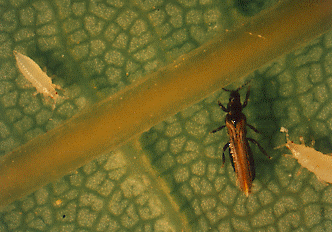

Home |
About Us
| IPM |
Asian
Longhorned Beetle |
SunnPest |
International | Database
| Publications | Presentations | Audio & Video

|
|
Pilot testing. Field testing select fungal isolates against pear thrips.
Basic biology. Determining yearly overwintering population levels in 40 Vermont sugarbushes.
Forecasting. Alerting sugarmakers to the potential for damage to their trees and suggesting management actions.|
|

Hemlock Woolly Adelgid
HEMLOCK WOOLLY ADELGID (HWA) This
destructive introduced pest is a major threat to eastern and Carolina
hemlock trees throughout their range. It presently infests trees
in 11 eastern states and is causing significant mortality of hemlocks
in forests and urban communities. Few options are available for
control of this pest. The use of pesticides is limited because in
forested lands, hemlocks often grow along streams, swamps, or
lakes and the threat of aquatic pollution is great. In urban
communities the general public does not favor the use of these
materials. Alternative management options are needed and the
potential use of entomopathogenic fungi is a viable tool for
consideration.
|
|
| Pathogenicity trials. Isolates
have been screened for pathogenicity against thrips, aphids and HWA. Isolation and identification. All fungi discovered were isolated, established in pure culture and identified. Exploration. Cooperative efforts in ME, MA, CT, NJ and VA led to the isolation of many insect-killing fungi associated with HWA populations. Exploratory activities were also conducted in China where HWA originated. Characterization. Isolates have been evaluated to determine their growth, sporulation and germination characteristics. Biological studies. Hypothesizing that range expansion of HWA is limited, trials were designed to determine the low lethal temperatures of this pest. Tests are also being done to ascertain if HWA populations from different plant coldhardiness zones respond differently to low temperature exposures. |
|---|
|
|
Home | About Us
| IPM | Asian
Longhorned Beetle | SunnPest |
International | Database
| Publications | Presentations | Audio & Video